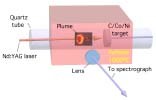Research - Nanomaterials Synthesis

Carbon nanotube synthesis by laser vaporization and chemical vapor deposition
Pulsed Laser Deposition of thin films
Gas-phase nanoparticle formation
NEW Watching nanotubes grow during chemical vapor deposition - Laser reflectivity from vertically-aligned arrays of multiwall nanotubes is providing some of the first direct measurements of how fast nanotubes grow, and the dynamics of their growth.
Single-Wall Carbon Nanotubes - Exploring the Laser-Vaporization Synthesis Process - The synthesis of single-walled carbon nanotubes (SWNTs) by laser vaporization (LV) was pioneered by the group of Richard E. Smalley at Rice University in 1995-1996. Here we review our work in unraveling the time scales, rates, and mechanisms of SWNT growth by LV through our time-resolved imaging and spectroscopy measurements.
.
Comment on "Single-Crystals of Single-Walled Carbon Nanotubes Formed by Self-Assembly" - Schlittler et al. (1) reported the production of single crystals of single-walled carbon nanotubes (SWCNTs) by the thermolysis of nanopatterned structures of alternating layers of C60 and nickel. Electron diffraction, high-resolution phase contrast imaging, and electron energy loss spectroscopy (EELS) were used to characterize the resulting crystals. In this comment, we report the reproduction of their experimental results; however, we disagree with their interpretation of the data. We suggest that the crystals formed in our experiments consist not of SWCNTs, but rather of calcium molybdenum oxide.
Photoluminescent Si Nanoparticles - Reveal how Nanoparticles form by Laser Ablation - When a Si wafer is ablated into a background gas, ablated atoms and molecules are confined as a hot plasma. After cooling by the gas, however, they condense into clusters of atoms and nanoparticles (a 25-atom Si cluster is 1-nm in size). Luminescent silicon has been the subject of much research. Here, we create photoluminescent SiOx clusters in the gas phase by condensation, and use this luminescence to track the nanoparticles as they form, and propagate. The gas-phase photoluminescence spectrum (induced by a time-delayed second laser) reveals interesting vibronic structure.
Carbon
Nanotube-Based Molecular Electronics- Powerpoint Presentation Describing
ORNL's Program in Carbon Nanotube-Based Molecular Electronics
Presented by D. Geohegan at ORNL's Nanoscience Day, May 15, 2001, which featured
a lecture by Nobel Laureate Rick Smalley.
Overview
of Nanotube Device Development LDRD Program at ORNL
Nanomaterials
Science at Oak Ridge National Laboratory PDF file (2.5 Mb) giving a
brief description of ORNL ongoing/future projects in nanoscience in Oak Ridge,
including the planned CNMS (Center for Nanophase Materials Sciences)
Presented at NSF's "Partnership in Nanotechnology" early-2001 workshop see
http://www-unix.oit.umass.edu/~nano
